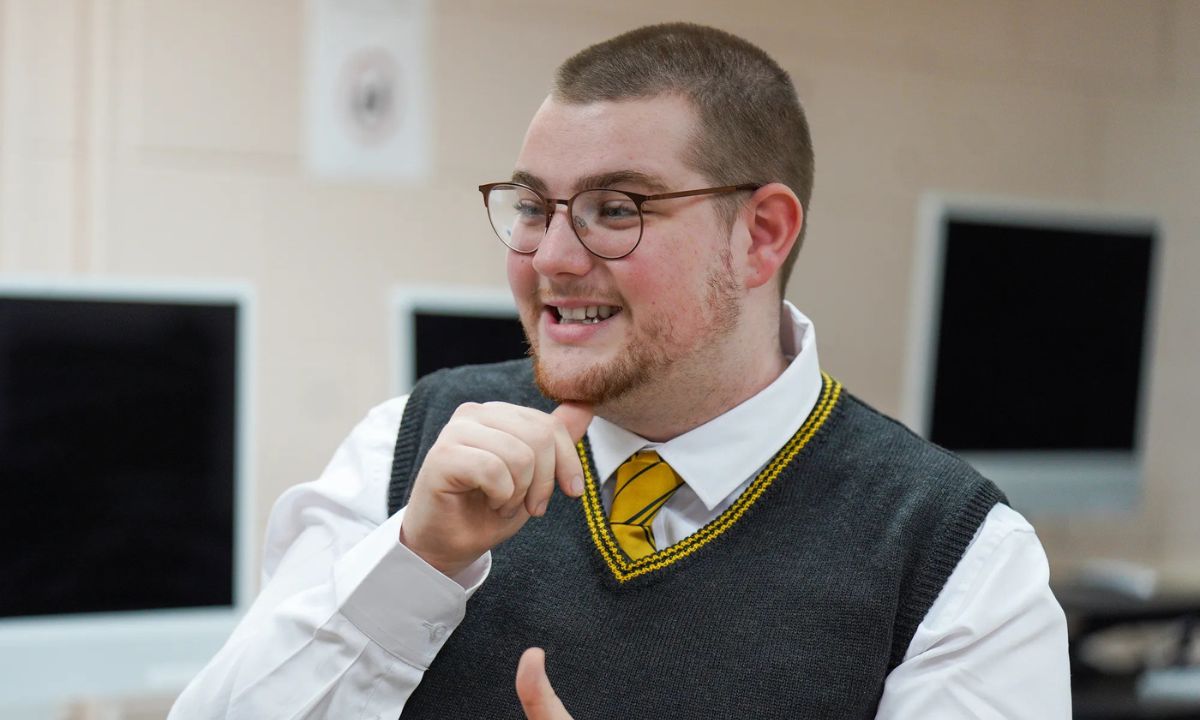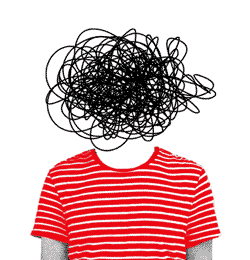Vincennes University Program Offers Immersion Into Deaf Culture
The ASL and Deaf Studies program is unique: Professors are deaf & teach classes in ASL. Students are surrounded by other deaf teachers and students.

Get stories like this delivered straight to your inbox. Sign up for The 74 Newsletter
The halls of Vincennes University’s campus on the north side may sound silent to people who can hear.
That’s intentional. Students who want to become American Sign Language interpreters need complete immersion into a world where most communication is already happening through ASL. That’s why the campus is located at the Indiana School for the Deaf.
Vincennes’ ASL and Deaf Studies program is unique: Professors are deaf and teach classes in ASL; and students are also surrounded by Indiana School for the Deaf teachers and students, especially at events outside of class.
“The second that we walk in these doors and we walk into a classroom, our voices have to be off,” said Abigayle Suding, a first-year student. “It’s all sign language.”
Vincennes professors know ASL is more than a means of communication. By sharing their lived experiences of being deaf, faculty help bring students who can hear into the Deaf community and culture.
“Without one, you cannot understand the other,” department chair Bonnie Conner said through an ASL interpreter. “That culture is ingrained in deaf people, and therefore, they are the only ones who can truly and authentically teach it to other people.”
Learning Deaf culture
Though Vincennes University’s main campus is in southern Indiana, Indianapolis has a large and vibrant Deaf community. In 2020, Marion County was home to over 78,000 deaf and hard of hearing people, per state data.
Faculty wanted students to be able to interact with the community and attend events in Indianapolis, which gives students insights they can’t learn in the classroom. Knowing that culture will ultimately help students become better at ASL, Conner said.
“You can teach it and teach it and teach it all day long,” Conner said. “However, when it’s time and you can actually see and witness it and be involved in it in real time, that is something that cannot be taught.”

Vincennes’ program, which has about 40 students, offers associate degrees and certificates, as well as some dual credit options for high schoolers. A majority of the students go on to receive their bachelor’s degrees in ASL interpreting.
Learning ASL as a language goes far beyond signing the alphabet. The language has its own grammar and syntax, which includes using facial expressions to communicate your tone.
As part of the program, students also take Deaf culture and community classes. In addition to Deaf history, students learn about cultural nuances, such as turning lights on and off to get attention.
For Conner, it’s important to communicate to her students that deaf people are not broken and live independent, fulfilling lives.
But she also wants to highlight the barriers she and other deaf people face every day, trying to communicate in a world that’s set up for people who can hear.
“Teaching these hearing students that it is their jobs to be working alongside us instead of against us, and how to learn how to be advocates for us as well,” she said, “That’s the main goal.”

Many of the students in the program are pursuing careers as ASL interpreters, hoping to fill a critical shortage of interpreters both nationwide and in Indiana. In Indiana, there are only about 200 nationally certified interpreters, according to Deaf Services Unlimited.
“We are in desperate need of interpreters, and we need them, at least to communicate,” Conner said. “It’s very difficult because so few hearing people actually know American Sign Language.”
Bridging the gap
For Suding and Ethan Akamu, another Vincennes first-year student, signing doesn’t end in the classroom.
“We sign the majority of the time,” Akamu said. “We probably sign more than we talk. Even in public, people think we’re deaf because we sign.”
Akamu took ASL in high school, where he “fell in love with the language.” As a hearing person who’s involved in the Deaf community, it’s important to him to share it with the people in his life.
“Not a lot of hearing people know how to communicate with the Deaf culture and Deaf community,” Akamu said. “I want to help bridge that gap so that there’s not as much of a communication barrier.”
Like Akamu, many students in the program have previously taken ASL in high school. But some have even deeper connections to the community.
Marybeth Goodwin, 25, is a child of deaf adults. Her first language was ASL, and she’s been signing all her life. She’s hoping to become an interpreter to continue to serve the community her parents raised her in.
Goodwin, a first-year student, hopes more schools will start offering ASL, especially to young kids. As a hearing person, she wants the world to be a more inclusive place for the Deaf community, which has always welcomed her with open arms.
“We’ve always got to keep up with that,” she said, “and learn and be an ally for them.”
About Vincennes’ Indianapolis campus
Vincennes University’s ASL and Deaf Studies program is located at the Indiana School for the Deaf, 1200 42nd St.
You can apply to the program online.
Vincennes also has a flight school located at Eagle Creek Airpark, where students study aviation technology.
Mirror Indy reporter Sophie Young contributed to this story.
This article first appeared on Mirror Indy and is republished here under a Creative Commons license.
Get stories like these delivered straight to your inbox. Sign up for The 74 Newsletter

;)